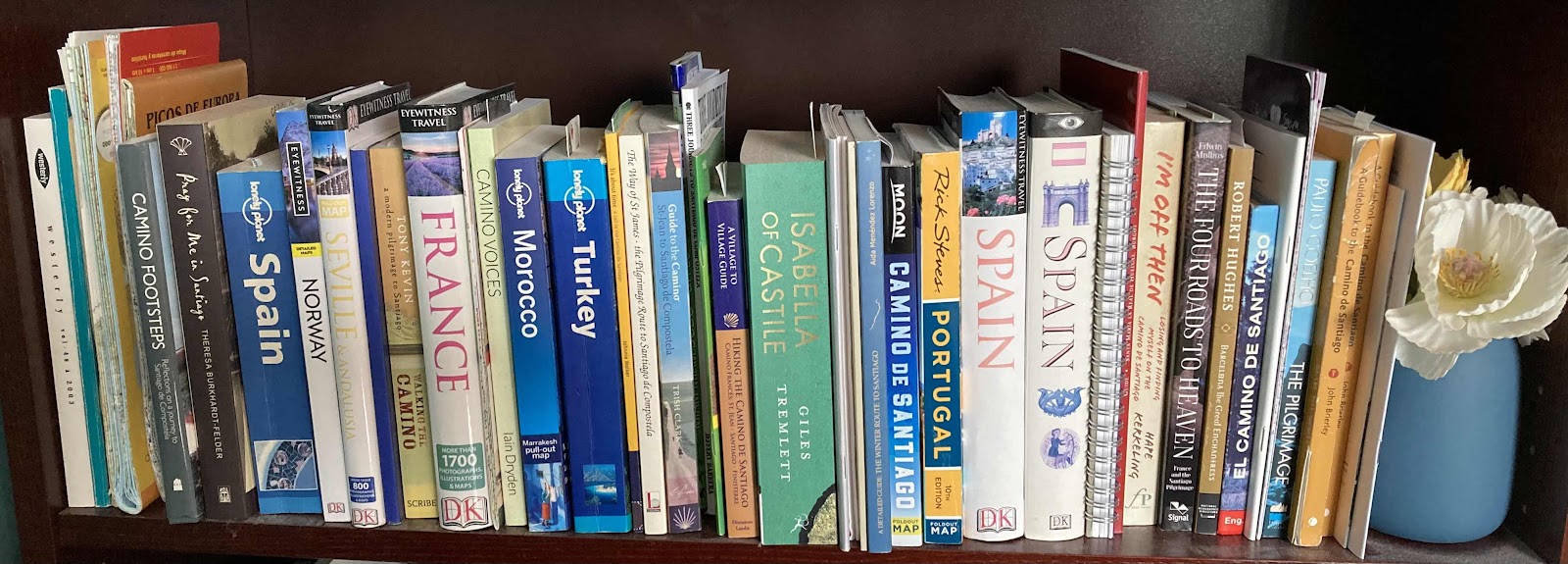Paul Genoni (2011) The pilgrim's progress across time: medievalism and modernity on the road to Santiago,Studies in Travel Writing, 15:2, 157-175, DOI: 10.1080/13645145.2011.565580
Recently I came across this scholarly journal article which reviews books about the Camino. There are 42 references. It only deals with
published works up to about 2008. These are pilgrim authors “with pens, not IPhones” and some are slightly disparaging about “non-reflective, lightly edited versions of diaries apparently kept while on Camino”. That is an accurate description of me and my blog! However, my bookshelf contains many of the works reviewed:

It’s important to reveal first of all that I know the author, Paul Genoni. He was my supervisor years ago when I studied at Curtin University, but this was before he or I became interested in the Camino. Secondly, he has never actually walked The Way. There are indications of this in that he doesn’t know the difference between a
credencial and a
compostela and also by his continued references to
refugios as opposed to
albergues. But we won’t hold that against him!
An expert in literary criticism, he examines the books in detail. One aspect is looking at the motivation for pilgrimage. One theory is turning one’s back on modernity, even a rejection of modern life in the nostalgia for the past. For me, I spend a lot of time looking at historic buildings, especially Romanesque churches, on the Camino. Born in England, but now living in Australia, I really miss seeing medieval history all around me. But I don’t reject modern life as I need a plane to get there.
He also considers the issue of what makes a “true pilgrim”. Is it the undertaking of an arduous journey, walking every step of the way, carrying a backpack, staying in dormitories? I used to think this at the beginning, but as I get older I sometimes take a bus, I use a baggage transfer service and I stay in hotels, even Paradors occasionally. I don’t walk more than 15 kms a day if I can help it. I read that medieval pilgrims normally walked 14 kms in a day and that the more affluent people rode on horseback. They were all cared for in monasteries and other religious establishments along the way and didn’t have to worry about accommodation as we do today. There were hospitals en route for them - but remember, they had to walk home again, unable to jump on a plane at Santiago Airport. For security, they mostly walked in groups, and probably had a lot of fun, as described in Chaucer’s Canterbury Tales.
The feeling of austerity as an import aspect of pilgrimage is discussed. For me, this meant that I only had what would fit in my backpack and I wore the same thing every day. This made life easy and an immense change for someone with an overflowing wardrobe at home! The austerity made itself felt when I couldn’t go shopping in the main street of Leon. Buying anything was out of the question because it would have to be carried. What is not mentioned is the common adage “the Camino provides” and the expectation that “Camino Angels” appear when you need them: and they do. There are examples in my blog: I was once helped across a fast flowing stream that I was too afraid to cross on my own.
I could go on, but I won’t. I’m not really a reviewer, but I felt that this one was worth mentioning!